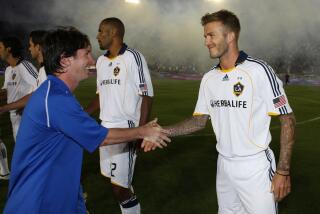Pele Remains Larger Than Life
SAO PAULO, Brazil — It has been almost 30 years since Pele -- aka Edson Arantes do Nascimento -- played his last soccer match, an exhibition at Giants Stadium in New Jersey, cheered on by a crowd of 75,000.
Pele played the first half for the New York Cosmos and the second half for Santos, his former Brazilian club. During the game, it began to rain. The next day, a newspaper headline read: “Even the sky was crying.”
On a recent day in the three-time world champion’s new office in Sao Paulo, no one was crying. Quite the opposite. Pele is in extremely good shape and his words are often followed by a heartfelt laugh. The new office is for his franchise activities, Pele said. Another office is found in his hometown of Santos.
“The office in Santos is more comfortable,” he said. “It’s located by the beach. My family lives in Santos, and I have my booth at the local stadium. In Santos I also work with kids -- young players under 18 -- and help select good players for Santos. We have a lot of kids there who need help.”
Pele himself has managed to stay on top since the day in 1958 when, at 17, he scored against Sweden in the World Cup finals in Stockholm -- and became the world’s youngest World Cup champion. Pele has traveled all over the world since those days. Recently, he has been traveling to promote this summer’s World Cup, and he is still amazed by the warmth and enthusiasm that people greet him with everywhere he goes. Even kids who never saw him play.
“Maybe their fathers saw me play,” Pele wondered as he attempted to explain his lifelong popularity:
“I respect my fans, I respect their fathers and I respect their grandfathers,” he said, laughing. “I think I am here, and am what I am, because of the support from my fans. I think their support is a gift from God. I try to set a good example, and I try not to disappoint people who follow me.”
One of the more popular films in the recent Tribeca Film Festival was “Once in a Lifetime: The Incredible Story of the New York Cosmos.” Most of the principals were interviewed. Pele was not, the filmmakers implying that he wanted too much money to talk to them. But Pele does not shy away from reporters.
America still has a special place in Pele’s life, he said, and he visits the country every year. He owns an apartment in Manhattan, and his daughter is married to an American doctor.
“They have three children, so I am grandfather to three Americans,” he said. “I go to the U.S. every summer. My daughter has a house in Long Island. It is a beautiful place, very quiet, so every time I’m in New York, I escape to her house, where I go fishing. In New York, I normally go to the theaters and I go to the games with the kids.”
When Pele arrived in New York in 1975, America was not exactly famous for soccer. Steve Ross, who was chairman of Warner Bros., saw Pele as an opportunity to lift the Cosmos among the world’s top soccer clubs. At that time, toward the end of his career, Pele had turned down offers from several famous European clubs, so it came as a great surprise when his move to America was announced.
“I was invited to promote soccer in America,” he said. “Warner Bros. asked me to help the New York Cosmos. At the time I was playing for Santos, who was champion, and I was the top scorer. The president of Fiat offered me stocks in Fiat if I went to Juventus.
“I remember [people] saying: ‘You are crazy. Go to Italy!’ I said: ‘No, if I go to Italy or Spain, it will be the same as if I continued to play here. And even more tough, because in Europe the level is tougher.’ So I went with my family to America. My kids went to school there, and now my three kids speak English, Spanish and French.”
The New York arrival of Pele made soccer trendy almost overnight. In 1974, the year before Pele’s arrival, the crowds for Cosmos games reached an average of 3,500. When Cosmos won the NASL title in 1977, the average was 34,000. The players had become regulars at Studio 54 and were surrounded by millionaires, celebrities such as Steven Spielberg, Robert Redford and Mick Jagger. The same year, writer Anthony Hiss described this new American phenomenon, soccer-mania, in the New Yorker:
“Five thousand people, the most excited crowd that has hit Kennedy Airport since the Beatles came to New York in 1964 to do ‘The Ed Sullivan Show,’ mobbed the New York Cosmos, the new champions of the North American Soccer League, when they flew back to town last week after squeezing by the Seattle Sounders in Soccer Bowl ‘77, in Portland, Oregon, and suddenly the whole town was talking soccer, although not very knowledgeably.”
There were several stars on the winning team, players such as Carlos Alberto (captain for the Brazilian World Cup winners in 1970) and Franz Beckenbauer (captain for the German World Cup winners in 1974), but Pele was in a league of his own. And not only as a soccer player. A survey had shown that next to Coca-Cola, Pele was the most famous brand in Europe. In the early 1960s, Brazilian President Janio Quadros had declared Pele a national treasure. And national treasures are not for sale.
But America was not only the land of opportunity for Pele and his family. Today, Pele realizes that both Brazil and America benefited from his American adventure.
“I think this was the first time Brazil sold know-how to the U.S.,” he said with a smile. “We really showed them how to play the sport, and the ‘70s was the beginning.”
*
Peter Christensen in a freelance writer from Denmark.







